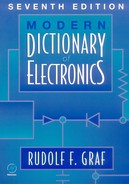Preface
When the first edition of this dictionary was published in 1961, today’s everyday items like color TVs, VCRs, CD players, computers, FAX machines, ATMs, cordless and cell phones, pagers, tape recorders, digital watches, pocket calculators, lasers, and many others too numerous to mention, were non-existent or mere laboratory curiosities. Since then, electronics has undergone significant changes based primarily on the meteoric expansion of integrated circuits and their apparently limitless applications. Vacuum tubes were replaced by semiconductors, and numerous technologies like ferrite core or bubble memories were relegated to the electronics graveyard. No other industry has ever grown so much and matured so fast, paced by technological advances that occur at a feverish pace. The first edition of this dictionary contained about 10,000 definitions of then current terms. And now, a scant 38 years later, this seventh edition contains approximately 25,000 terms — a clear indication of the phenomenal growth of our industry.
As technologies evolve and fresh products and concepts are introduced, suitable terminology must be developed to be able to communicate. The originators of the new words give them their initial meaning, but their exact definitions change with technological advances and through actual use by others. The contents of this dictionary is thus an analysis of words and their meanings as determined by common usage, written in a modern and popular style to provide clear and concise explanations of each entry. Continual updating of a work such as this is vital, so that those involved in the world of electronics have the power to communicate with those about them and to grasp new concepts as they emerge.
All entries are allowed as much space as is necessary for complete and meaningful definitions. Terms are explained clearly and precisely without excessive technical jargon. Original entries from the previous edition have been reviewed and many were revised to keep pace with current usage. Where more than one definition exists for a term, they are arranged numerically. This method, however, does not necessarily imply a preferred order of meanings. Important words from formative technologies that are no longer in use are retained in this edition for their historical interest.
My thanks go out to Ms. Tara Troxler Thomas and to Charles Thomas whose dedication to this project and skill at the word processor made it possible to deliver the manuscript for this work to the publisher in a timely fashion.
Industry and technical sources — notably the IEEE and the ASA — generously aided in defining many terms during the preparation of earlier editions of this work.
While this volume is as up-to-date as possible at the time of writing, the field of electronics is expanding so rapidly that new terms are constantly being developed and older terms take on broader or more specialized meanings. It is the intention of the publisher to periodically issue revised editions of this dictionary; thus suggestions for new terms and definitions are always welcome.
